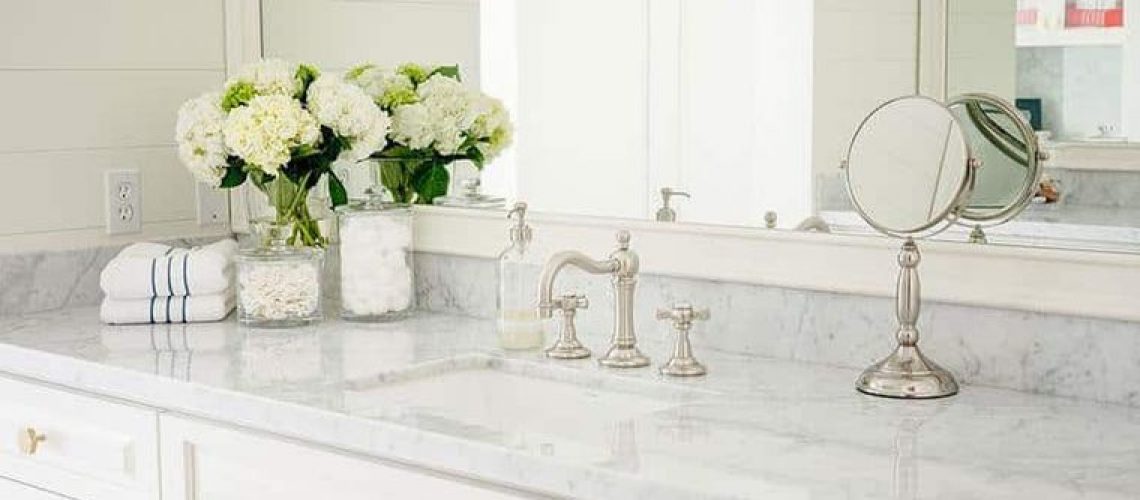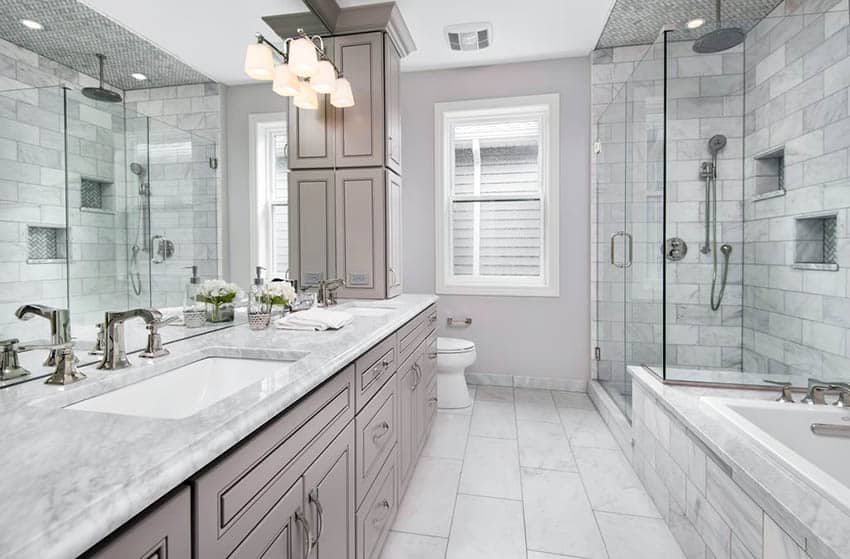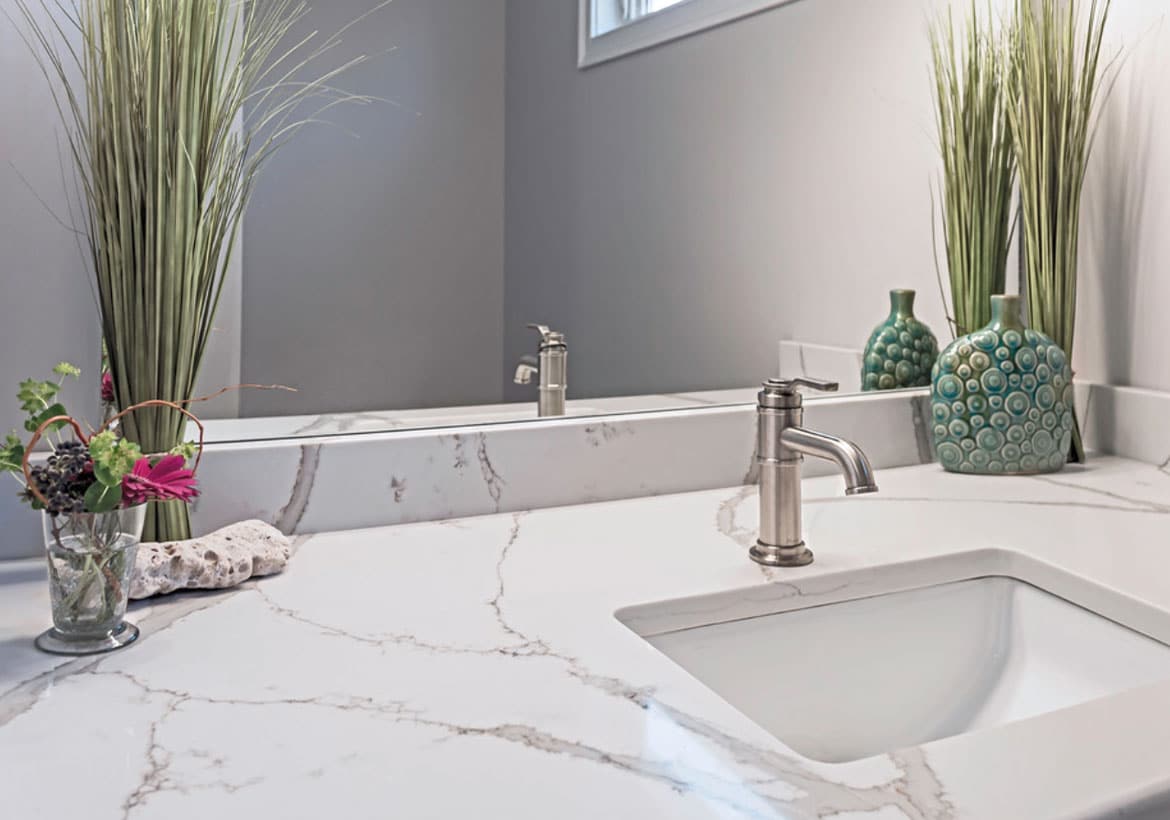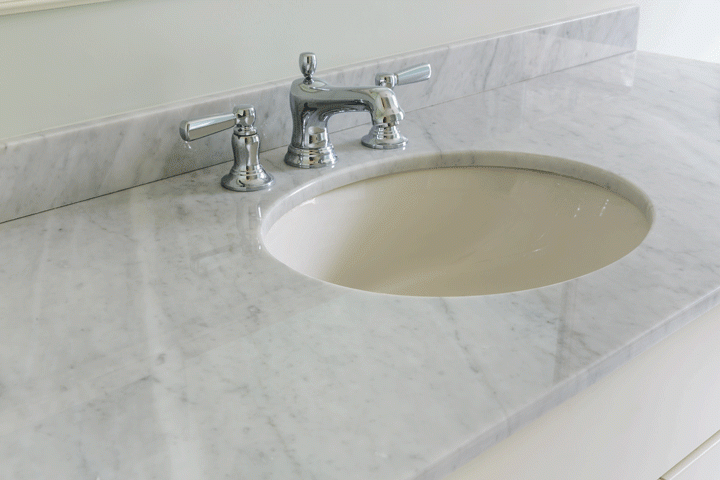Marble has long been prized for its elegance and timeless beauty, making it a popular choice for bathroom countertops. Its luxurious appearance, with distinctive veining and a wide range of colors, can elevate the aesthetic of any bathroom. Marble is a metamorphic rock composed mainly of calcite, formed under high pressure and temperature conditions. This natural stone offers a unique look, as no two slabs are identical, providing a custom and high-end feel to your bathroom space.
One of the primary reasons homeowners choose marble for bathroom countertops is its aesthetic appeal. Marble’s natural veining patterns and color variations can complement various bathroom styles, from classic to contemporary. The stone’s translucent quality allows light to penetrate its surface, giving it a soft, glowing appearance. Colors range from the traditional white and gray tones to more exotic hues like greens, reds, and blacks, making it versatile enough to suit different design preferences.
However, the beauty of marble comes with a few considerations. Marble is a porous material, which means it can absorb liquids and stains more easily than other countertop options. This characteristic necessitates regular sealing to protect the surface from moisture, soap, and cosmetic products commonly used in bathrooms. A high-quality sealant can significantly reduce the risk of staining and make the countertop easier to clean, though it requires periodic reapplication to maintain its protective properties.
Another important factor to consider is marble’s susceptibility to etching. Etching occurs when acidic substances, such as lemon juice or certain cleaning products, come into contact with the stone and cause a dull, discolored spot. This can be particularly problematic in bathrooms, where products like shampoo, toothpaste, and various beauty treatments are frequently used. To minimize etching, it’s crucial to use pH-neutral cleaners and to wipe up spills immediately.
Marble is also relatively soft compared to other natural stones, such as granite or quartzite. This means it can be scratched or chipped more easily, especially in a high-traffic area like a bathroom. While minor scratches can sometimes be polished out, deeper chips and cracks may require professional repair. Using mats, trays, or coasters can help protect the surface from heavy or sharp objects, extending the life of your marble countertop.

Despite these drawbacks, marble remains a desirable choice for many due to its unparalleled elegance and the way it can enhance the overall look of a bathroom. When properly maintained, a marble countertop can last for decades, adding value to your home and providing a beautiful, functional surface. For those who are willing to invest the time and effort into proper care, marble can be a rewarding choice.
Another advantage of marble is its ability to stay cool. This characteristic is particularly beneficial in bathrooms where hair styling tools like flat irons and curling irons are used. The natural coolness of marble can help dissipate heat quickly, reducing the risk of heat damage. Additionally, for those living in warmer climates, marble can provide a refreshing cool touch, enhancing comfort in the bathroom.
In terms of cost, marble countertops are generally more expensive than other materials such as laminate or solid surface options. The price varies depending on the type and quality of marble chosen, with rarer colors and patterns commanding higher prices. However, many homeowners consider the investment worthwhile due to marble’s durability, beauty, and the value it adds to their property.

For environmentally-conscious consumers, it’s worth noting that marble is a natural material that can be sourced locally or internationally. The environmental impact of marble varies depending on the quarrying and processing methods used, as well as the distance it must be transported. Choosing marble from a reputable supplier who follows sustainable practices can help reduce its environmental footprint.
Maintenance of marble countertops is relatively straightforward but requires diligence. Regular cleaning with a soft cloth and a mild, pH-neutral cleaner is recommended to avoid damaging the surface. Avoid using abrasive pads or harsh chemicals, which can scratch or etch the marble. Periodic sealing, as mentioned earlier, is also necessary to protect the stone from stains and moisture.
In addition to countertops, marble can be used for other bathroom elements such as vanity tops, shower surrounds, and flooring, creating a cohesive and luxurious look. Using marble throughout the bathroom can enhance the sense of space and provide a unified design. However, it’s essential to consider the additional maintenance and care required to keep all marble surfaces looking their best.
One potential downside to consider is the slipperiness of polished marble when wet. This can pose a safety risk, particularly in areas like bathroom floors or shower surrounds. Choosing a honed finish, which has a matte appearance and provides more traction, can mitigate this issue. For countertops, the finish choice is more about personal preference and the desired aesthetic.
In summary, marble is a beautiful and timeless choice for bathroom countertops, offering a unique and luxurious look. Its natural variations and translucent quality can enhance the visual appeal of any bathroom. However, marble requires regular maintenance and care to protect it from stains, etching, and scratches. For those willing to invest in its upkeep, marble can provide a durable and elegant surface that adds value and sophistication to their home.

Common Mistakes to Avoid:
Using Acidic Cleaners: Acidic cleaners, including vinegar, can etch the surface of marble, leaving dull spots. Always use pH-neutral cleaners specifically designed for natural stone.
Neglecting Sealing: Skipping regular sealing can leave your marble countertop vulnerable to stains and moisture damage. Ensure you seal your countertop at least once or twice a year.
Allowing Spills to Sit: Leaving spills, especially from acidic substances like lemon juice or beauty products, can cause permanent damage. Wipe up spills immediately to protect the surface.
Using Abrasive Pads: Abrasive pads and cleaners can scratch the marble surface. Use a soft cloth or sponge for cleaning.
Ignoring Professional Maintenance: Deep scratches and etches often require professional polishing and repair. Ignoring these can lead to further damage and deterioration of your marble countertop.

How often should I seal my marble bathroom countertop?
Sealing your marble bathroom countertop is essential to protect it from stains and moisture. Generally, it is recommended to seal marble countertops every six months to a year, depending on the usage and type of sealant used. High-traffic areas may require more frequent sealing. Regularly test the seal by placing a few drops of water on the surface. If the water is absorbed, it’s time to reseal.
Can I use regular household cleaners on my marble countertop?
No, regular household cleaners, especially those containing acids or abrasives, can damage marble. Acidic cleaners, including those with vinegar or lemon, can etch the surface, while abrasive cleaners can scratch it. Instead, use pH-neutral cleaners specifically designed for natural stone. Regularly wiping the surface with a soft cloth and a mild stone cleaner will help maintain its appearance.
What should I do if my marble countertop gets stained?
If your marble countertop gets stained, it’s important to address it quickly. Blot the stain with a soft cloth to absorb as much as possible. Avoid rubbing, as this can spread the stain. For organic stains, such as those from food, a poultice made of baking soda and water can help lift the stain. Apply the poultice, cover it with plastic wrap, and leave it for 24-48 hours before wiping it away. For more stubborn stains, consulting a professional may be necessary.
Is marble a durable choice for bathroom countertops?
Marble is durable but requires proper care and maintenance to retain its beauty and functionality. It is more prone to scratches, stains, and etching compared to harder stones like granite. However, with regular sealing, careful cleaning, and immediate attention to spills, marble can last for decades. Its timeless elegance often outweighs its maintenance needs for many homeowners.
How can I protect my marble countertop from scratches and etching?
To protect your marble countertop from scratches and etching, use coasters, trays, and mats to prevent direct contact with acidic substances and sharp objects. Avoid placing heavy or sharp items directly on the surface. Regularly seal the countertop to create a protective barrier against spills and moisture. Using cutting boards and trivets can also prevent damage from knives and hot cookware.
Color Palette Tips for Bathroom Countertops – KNC Granite

Best Bathroom Countertops (Design Ideas) – Designing Idea

Orlando Marble Bathroom Countertops All Quality Granite

Cultured Marble vs. Granite: Choosing the Best Material in 2021

Related articles:
- Replace Bathroom Countertop
- Bathroom Countertop Refinishing
- Is Marble A Good Choice For Bathroom Countertops
- Solid Surface Bathroom Countertop Options
- How To Paint A Bathroom Countertop
- White Granite Bathroom Countertops
- Wood Countertop For Bathroom Vanity
- Rustic Bathroom Countertop Ideas
- Price For Granite Bathroom Countertops
- Bathroom Countertop Covers